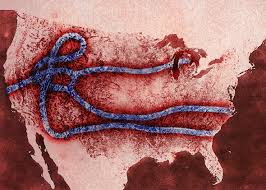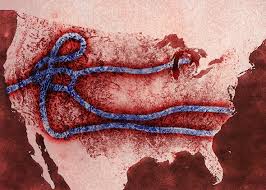Its germ season and with the growing concerns over Ebola spreading within the United States I thought it might be wise to discuss PREVENTION verses what to do ‘if’ as prevention is obviously our first line of defense.
Soap and hot water are our obvious first bet as always. Several times a day. But I know and understand that this isn’t always possible so alternatives to keeping our hands as germ free as possible are next in line. I will speak directly to viruses (and this includes Ebola) as not all alternatives are good for bacterial disinfection.
According to the MSDS and The Canadian Centers for Disease Control there are basically 4 ways to kill ‘enveloped’ viruses such as the flu, ebola and many ‘stomach bugs’ that are emerging right now.
Phenolic compounds which are found in many of our everyday items we use such as: They can be toxic at certain levels, though hospitals still use phenolic compounds to clean floors, bed railings and tables. You will know you have a sanitizing phenolic compound if you see the ‘phenol’ in any part of the ingredients. A few that I found were: ortho-phenylphenol, ortho-benzyl-para-chlorophenol, ortho-phenylphenol, para-tertiary-amylpheno.
Typically phenolic sanitizers will need to be left to dry for at least 10 minutes (typical time to work to ‘inactive’ a virus) Do NOT get on the skin or inhale the vapors (such as in air ‘sanitizers’). You should also not use these products containing phenolic compounds around babies or young children nor on surfaces where food may touch.
Ethyl or Isopropal alcohols. These are found in hand sanitizers and common rubbing alcohol…but here is the catch. NOT ALL hand sanitizers have their main ingredient as ethyl alcohol. Remember the big scare about children eating hand sanitizer and getting sick? Some of the more popular brands changed their formulations and do NOT have ethyl alcohol as its active ingredient. So be sure you look at the ingredient list on the hand sanitizer you buy and make SURE it says Ethyl alcohol. And it must be at least 62% but no more than 70%.
As for rubbing alcohol, you can use this on surfaces, your hands or body. But here is the catch: it has to be 60 to 70 percent isopropyl alcohol. If any higher it will not as effective. Science has shown that to kill enveloped viruses such as Ebola, MRSA, and Influenza you must have water to penetrate the virus. They love water! So, the more water the rubbing alcohol is diluted in the better the kill rate. Optimal is 60-70 percent of isopropyl rubbing alcohol. Do NOT ingest any of type of ethyl or rubbing alcohol.
Next, and most prolific in disinfectants and used in hospitals are the Ammonium Chlorides. Look for cleaning, disinfecting/sanitizing products with the words ammonium chloride in the ingredients as these will kill any enveloped virus…ebola, flu, HIV, etc. It can be found in sanitizing wipes, many surface cleaners and in fact, is the main chemical used by hair stylists for disinfecting there clippers and scissors. Goes by the brand name Hydrocide which is readily available to the public. Clorox wipes contain ammonium chloride. NOTE OF CAUTION. If you are going to use a product with ammonium chloride you allow to air dry. Do not wipe dry. Also, if you will be using on surfaces where you cook, after allowing to air dry it is advised to use plain water to wipe afterwards (10 to 15 minutes after using product) so that you do not eat this as it can build up in the body and cause a toxic reaction. Same goes for the aerosolized versions you find in disinfectant sprays…don’t breath it in.
Bleach is next on killing all sorts of viruses and bacteria and is a traditional stand by. However, I would not use on the skin as allergic reactions can occur and contact dermatitis can occur over repeated exposure to bleach. A 10% solution will work for hard, non-porous surfaces. Do NOT use on rubber as over time it will break it down.
Finally, we come to good old fashioned vinegar. According to the MSDS vinegar even at 3% dilution will kill ebola, influenza and many other enveloped viruses. Yes, that is SCIENCE. Often times you will see vinegar in homemade cleaning solutions. But personally I would just use it straight and it is safe for SKIN too!
As a note: you may also use a 50/50 combination of hydrogen peroxide and vinegar for cleaning hard surfaces as a disinfectant. This also has been shown to kill many viruses including ebola.
Stay safe, be prepared and get the knowledge to be panic free!
Survivingshtfmom
http://www.cdc.gov/hicpac/disinfection_sterilization/9_0pceticacidhydropoxide.html#a1
http://www.msdsonline.com/resources/msds-resources/free-safety-data-sheet-index/ebola-virus.aspx
http://www.phac-aspc.gc.ca/lab-bio/res/psds-ftss/ebola-eng.php
Click to access InfectionControl_GF_DisinfectntSelectnGuidelines_nov0503.pdf











Medical Research Org CIDRAP: Ebola Transmittable by Air
CIDRAP is warning that surgical facemasks do not prevent transmission of Ebola, and healthcare professionals (HCP) must immediately be outfitted with full-hooded protective gear and powered air-purifying respirators.
CIDRAP since 2001 has been a global leader in addressing public health preparedness regarding emerging infectious diseases and bio-security responses. CIDRAP’s opinion on Ebola virus is there are “No proven pre- or post-exposure treatment modalities;” “A high case-fatality rate;” and “Unclear modes of transmission.”
In April of 2014, CIDRAP published a commentary on Middle East respiratory syndrome (MERS) that confirmed the disease “could be an aerosol-transmissible disease, especially in healthcare settings,” similar to the known aerosol transmission capability of severe acute respiratory syndrome (SARS).
Although CIDRAP acknowledges that they were “first skeptical that Ebola virus could be an aerosol-transmissible disease,” they are “now persuaded by a review of experimental and epidemiologic data that this might be an important feature of disease transmission, particularly in healthcare settings.”
CDC’s published “Infection Prevention and Control Recommendations for Hospitalized Patients with Known or Suspected Ebola Virus Disease in U.S. Hospitals” states: “HCP should wear gloves, a gown, disposable shoe covers, and either a face shield that fully covers the front and sides of the face or goggles, and respiratory protection that is at least as protective as a NIOSH certified fit-tested N95 filtering facepiece respirator.”
N95 filters look like surgical masks and are defined by the U.S. Department of Labor as “disposable respirator” with a workplace protection factor (WPF) of 10. A 3M “qualified” N95 respirators rated to block 95% of airborne particles with a size greater in diameter than 5 microns is can cost as little as $.65 each.
However, the US National Institutes of Health reported in 2005 that 50% of bio-aerosols were found to be less than 5 microns in diameter. The NIH calculated that after correcting for dead space and lung deposition, “N95 filtering facepiece respirators seem inadequate against microorganisms.”
CIDRAP warns in regards to N95 respirators, “Healthcare workers have experienced very high rates of morbidity and mortality in the past and current Ebola virus outbreaks. A facemask, or surgical mask, offers no or very minimal protection from infectious aerosol particles.”
CIDRAP is now advising the CDC and WHO that proper “personal protective equipment (PPE) ensures that healthcare workers remain healthy throughout an outbreak.” Based on scientific research, CIDRAP recommends the minimum protection for healthcare professionals in high-risk settings is a “powered air-purifying respirator (PAPR) with a hood or helmet” that will filter 99.97% of all particles down to 0.3 microns in diameter.
But the minimum Internet-advertised price for a “qualified” 3M Veraflo respirator is $427.13, compared to about $.65 for an N95 facemask. With Liberia’s per capita GDP only $454 last year and the economy in shambles, there is no way the country’s healthcare professionals can afford to acquire the appropriate protective respirators.
Based on CIDRAP’s research and the fact that Ebola cases are projected to skyrocket, it seems irresponsible that the New York Times and other mainstream media outlets are downplaying the risks of Ebola transmission.
Less than two weeks ago, the NYT’s “Well” column responded to a reader’s question: “Can I get Ebola from public transportation?” with “Implying that Ebola is caught as easily as flu or colds would be untrue and inflammatory.” The “Well” column, again on October 13th, responded to another question: “I’m flying soon. What is the risk of contracting Ebola on a flight?” with “Top Ebola experts have said they would not expect to be infected even if they were sitting next to another passenger with Ebola – unless that passenger actually vomited or bled on them.”
As I pointed out last week at Breitbart News, the Black Death that killed a third of all people in Europe and the Middle East in the three years from 1337 to 1340 appears to have been a “hemorrhagic fever” similar to Ebola. CIDRAP’s warning that Ebola can be spread by “infectious aerosol particles,” such as breathing, means the pandemic should be expected to continue to accelerate.
Chriss Street suggests that if you are interested in Ebola, please read EXPERTS: EBOLA OUTBREAK, BLACK DEATH ‘PLAGUE’ SPREAD FROM AFRICA AS VIRUSES.